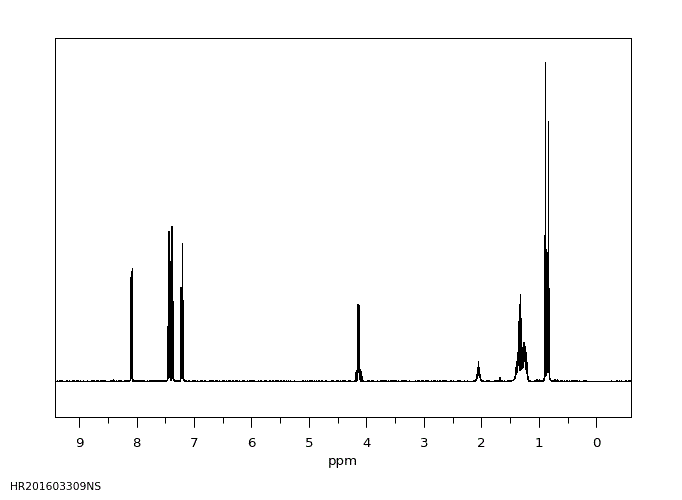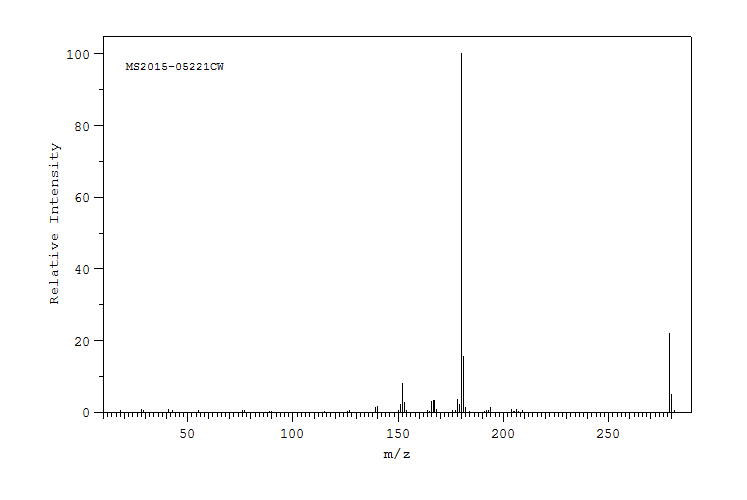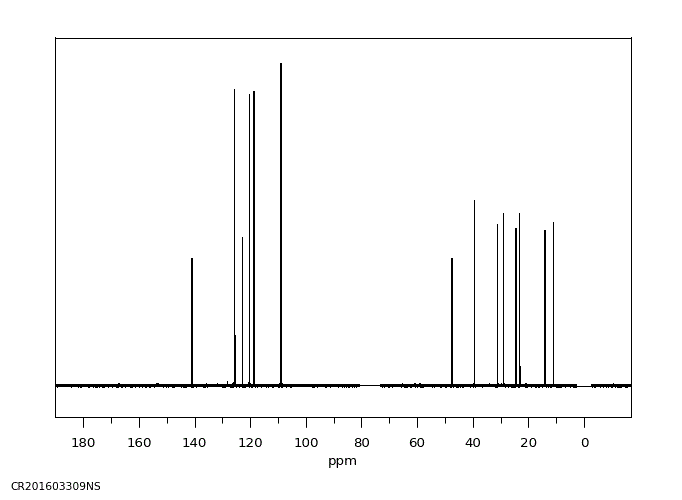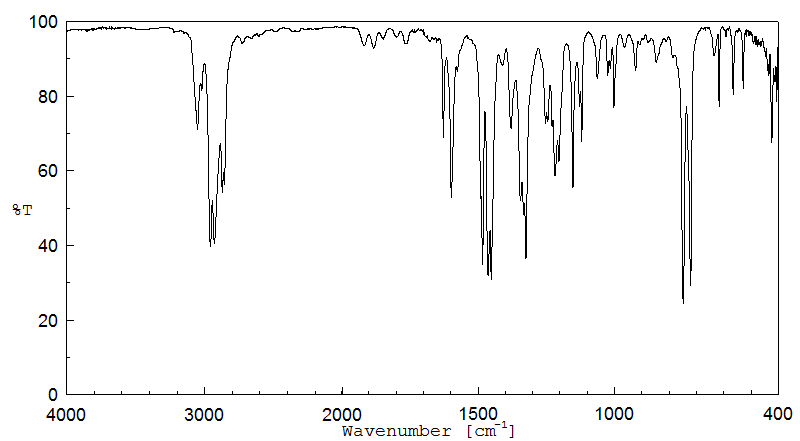9-(2-乙基己基)咔唑 | 187148-77-2
中文名称
9-(2-乙基己基)咔唑
中文别名
——
英文名称
N-(2-ethylhexyl)carbazole
英文别名
9-(2-ethylhexyl)-9H-carbazole;9-(2-ethylhexyl)carbazole
CAS
187148-77-2
化学式
C20H25N
mdl
——
分子量
279.425
InChiKey
SAXNQWFLHXTRDI-UHFFFAOYSA-N
BEILSTEIN
——
EINECS
——
-
物化性质
-
计算性质
-
ADMET
-
安全信息
-
SDS
-
制备方法与用途
-
上下游信息
-
文献信息
-
表征谱图
-
同类化合物
-
相关功能分类
-
相关结构分类
物化性质
-
沸点:40 °C/3 mmHg (lit.)
-
密度:1.004 g/mL at 25 °C (lit.)
-
闪点:>230 °F
-
稳定性/保质期:
常温常压下稳定,应避免与强氧化剂接触。
计算性质
-
辛醇/水分配系数(LogP):6.4
-
重原子数:21
-
可旋转键数:6
-
环数:3.0
-
sp3杂化的碳原子比例:0.4
-
拓扑面积:4.9
-
氢给体数:0
-
氢受体数:0
安全信息
-
危险品标志:T
-
安全说明:S26
-
危险类别码:R25
-
WGK Germany:3
-
危险标志:GHS06
-
危险品运输编号:UN 2810 6.1/PG 3
-
危险性描述:H301,H315,H319,H335,H413
-
危险性防范说明:P261,P301 + P310,P305 + P351 + P338
-
储存条件:密封保存,应储存在阴凉干燥的仓库中。
SDS
Section 1. IDENTIFICATION OF THE SUBSTANCE/MIXTURE
Product identifiers
Product name : 9-(2-Ethylhexyl)carbazole
CAS-No. : 187148-77-2
Relevant identified uses of the substance or mixture and uses advised against
Identified uses : Laboratory chemicals, Manufacture of substances
Section 2. HAZARDS IDENTIFICATION
Classification of the substance or mixture
Classification according to Regulation (EC) No 1272/2008 [EU-GHS/CLP]
Acute toxicity, Oral (Category 3)
Skin irritation (Category 2)
Eye irritation (Category 2)
Specific target organ toxicity - single exposure (Category 3)
Chronic aquatic toxicity (Category 4)
Classification according to EU Directives 67/548/EEC or 1999/45/EC
Toxic if swallowed. Irritating to eyes, respiratory system and skin.
Label elements
Labelling according Regulation (EC) No 1272/2008 [CLP]
Pictogram
Signal word Danger
Hazard statement(s)
H301 Toxic if swallowed.
H315 Causes skin irritation.
H319 Causes serious eye irritation.
H335 May cause respiratory irritation.
H413 May cause long lasting harmful effects to aquatic life.
Precautionary statement(s)
P261 Avoid breathing dust/ fume/ gas/ mist/ vapours/ spray.
P301 + P310 IF SWALLOWED: Immediately call a POISON CENTER or doctor/
physician.
P305 + P351 + P338 IF IN EYES: Rinse cautiously with water for several minutes. Remove
contact lenses, if present and easy to do. Continue rinsing.
Supplemental Hazard none
Statements
According to European Directive 67/548/EEC as amended.
Hazard symbol(s)
R-phrase(s)
R25 Toxic if swallowed.
R36/37/38 Irritating to eyes, respiratory system and skin.
S-phrase(s)
S26 In case of contact with eyes, rinse immediately with plenty of water and
seek medical advice.
S36/37/39 Wear suitable protective clothing, gloves and eye/face protection.
S45 In case of accident or if you feel unwell, seek medical advice immediately
(show the label where possible).
Other hazards - none
Section 3. COMPOSITION/INFORMATION ON INGREDIENTS
Substances
Formula : C20H25N
Molecular Weight : 279,42 g/mol
Component Concentration
9-(2-Ethylhexyl)carbazole
CAS-No. 187148-77-2 -
Section 4. FIRST AID MEASURES
Description of first aid measures
General advice
Consult a physician. Show this safety data sheet to the doctor in attendance.
If inhaled
If breathed in, move person into fresh air. If not breathing, give artificial respiration. Consult a physician.
In case of skin contact
Wash off with soap and plenty of water. Take victim immediately to hospital. Consult a physician.
In case of eye contact
Rinse thoroughly with plenty of water for at least 15 minutes and consult a physician.
If swallowed
Never give anything by mouth to an unconscious person. Rinse mouth with water. Consult a physician.
Most important symptoms and effects, both acute and delayed
Indication of any immediate medical attention and special treatment needed
no data available
Section 5. FIREFIGHTING MEASURES
Extinguishing media
Suitable extinguishing media
Use water spray, alcohol-resistant foam, dry chemical or carbon dioxide.
Special hazards arising from the substance or mixture
Carbon oxides, nitrogen oxides (NOx)
Advice for firefighters
Wear self contained breathing apparatus for fire fighting if necessary.
Further information
no data available
Section 6. ACCIDENTAL RELEASE MEASURES
Personal precautions, protective equipment and emergency procedures
Wear respiratory protection. Avoid breathing vapors, mist or gas. Ensure adequate ventilation. Evacuate
personnel to safe areas.
Environmental precautions
Prevent further leakage or spillage if safe to do so. Do not let product enter drains. Discharge into the
environment must be avoided.
Methods and materials for containment and cleaning up
Soak up with inert absorbent material and dispose of as hazardous waste. Keep in suitable, closed
containers for disposal.
Reference to other sections
For disposal see section 13.
Section 7. HANDLING AND STORAGE
Precautions for safe handling
Avoid contact with skin and eyes. Avoid inhalation of vapour or mist.
Normal measures for preventive fire protection.
Conditions for safe storage, including any incompatibilities
Store in cool place. Keep container tightly closed in a dry and well-ventilated place. Containers which are
opened must be carefully resealed and kept upright to prevent leakage.
Specific end use(s)
no data available
Section 8. EXPOSURE CONTROLS/PERSONAL PROTECTION
Control parameters
Components with workplace control parameters
Exposure controls
Appropriate engineering controls
Avoid contact with skin, eyes and clothing. Wash hands before breaks and immediately after handling
the product.
Personal protective equipment
Eye/face protection
Face shield and safety glasses Use equipment for eye protection tested and approved under
appropriate government standards such as NIOSH (US) or EN 166(EU).
Skin protection
Handle with gloves. Gloves must be inspected prior to use. Use proper glove removal technique
(without touching glove's outer surface) to avoid skin contact with this product. Dispose of
contaminated gloves after use in accordance with applicable laws and good laboratory practices.
Wash and dry hands.
The selected protective gloves have to satisfy the specifications of EU Directive 89/686/EEC and
the standard EN 374 derived from it.
Body Protection
Complete suit protecting against chemicals, The type of protective equipment must be selected
according to the concentration and amount of the dangerous substance at the specific workplace.
Respiratory protection
Where risk assessment shows air-purifying respirators are appropriate use a full-face respirator
with multi-purpose combination (US) or type ABEK (EN 14387) respirator cartridges as a backup
to engineering controls. If the respirator is the sole means of protection, use a full-face supplied air
respirator. Use respirators and components tested and approved under appropriate government
standards such as NIOSH (US) or CEN (EU).
Section 9. PHYSICAL AND CHEMICAL PROPERTIES
Information on basic physical and chemical properties
a) Appearance Form: liquid
Colour: colourless
b) Odour no data available
c) Odour Threshold no data available
d) pH no data available
e) Melting point/freezing no data available
point
f) Initial boiling point and 40 °C at 4 hPa - lit.
boiling range
g) Flash point > 110 °C - closed cup
h) Evaporation rate no data available
i) Flammability (solid, gas) no data available
j) Upper/lower no data available
flammability or
explosive limits
k) Vapour pressure no data available
l) Vapour density no data available
m) Relative density 1,004 g/cm3 at 25 °C
n) Water solubility no data available
o) Partition coefficient: n- log Pow: 7,088
octanol/water
p) Auto-ignition no data available
temperature
q) Decomposition no data available
temperature
r) Viscosity no data available
s) Explosive properties no data available
t) Oxidizing properties no data available
Other safety information
no data available
Section 10. STABILITY AND REACTIVITY
Reactivity
no data available
Chemical stability
no data available
Possibility of hazardous reactions
no data available
Conditions to avoid
no data available
Incompatible materials
Strong oxidizing agents
Hazardous decomposition products
Other decomposition products - no data available
Section 11. TOXICOLOGICAL INFORMATION
Information on toxicological effects
Acute toxicity
no data available
Inhalation: no data available
Skin corrosion/irritation
no data available
Serious eye damage/eye irritation
no data available
Respiratory or skin sensitization
no data available
Germ cell mutagenicity
no data available
Carcinogenicity
IARC: No component of this product present at levels greater than or equal to 0.1% is identified as
probable, possible or confirmed human carcinogen by IARC.
Reproductive toxicity
no data available
Specific target organ toxicity - single exposure
Inhalation - May cause respiratory irritation.
Specific target organ toxicity - repeated exposure
no data available
Aspiration hazard
no data available
Potential health effects
Inhalation May be harmful if inhaled. Causes respiratory tract irritation.
Ingestion Toxic if swallowed.
Skin May be harmful if absorbed through skin. Causes skin irritation.
Eyes Causes serious eye irritation.
Additional Information
RTECS: Not available
Section 12. ECOLOGICAL INFORMATION
Toxicity
no data available
Persistence and degradability
no data available
Bioaccumulative potential
no data available
Mobility in soil
no data available
Results of PBT and vPvB assessment
no data available
Other adverse effects
no data available
Section 13. DISPOSAL CONSIDERATIONS
Waste treatment methods
Product
Offer surplus and non-recyclable solutions to a licensed disposal company. Contact a licensed
professional waste disposal service to dispose of this material.
Contaminated packaging
Dispose of as unused product.
Section 14. TRANSPORT INFORMATION
UN number
ADR/RID: 2810 IMDG: 2810 IATA: 2810
UN proper shipping name
ADR/RID: TOXIC LIQUID, ORGANIC, N.O.S. (9-(2-Ethylhexyl)carbazole)
IMDG: TOXIC LIQUID, ORGANIC, N.O.S. (9-(2-Ethylhexyl)carbazole)
IATA: Toxic liquid, organic, n.o.s. (9-(2-Ethylhexyl)carbazole)
Transport hazard class(es)
ADR/RID: 6.1 IMDG: 6.1 IATA: 6.1
Packaging group
ADR/RID: III IMDG: III IATA: III
Environmental hazards
ADR/RID: no IMDG Marine Pollutant: no IATA: no
Special precautions for user
no data available
SECTION 15 - REGULATORY INFORMATION
N/A
SECTION 16 - ADDITIONAL INFORMATION
N/A
上下游信息
-
下游产品
中文名称 英文名称 CAS号 化学式 分子量 —— 5-(2-Ethylhexyl)naphtho[2,3-c]carbazole 1273320-77-6 C28H29N 379.545 3,6-二溴-9-(2-乙基己基)-9h-咔唑 3,6-dibromo-9-(2-ethylhexyl)carbazole 173063-52-0 C20H23Br2N 437.217 3-溴-9-(2-乙基己基)-9H-咔唑 3-bromo-9-(2-ethylhexyl)-9H-carbazole 628336-85-6 C20H24BrN 358.321 9-(2-乙基己基)咔唑-3,6-二胺 9-(2-ethylhexyl)-9H-carbazole-3,6-diamine 675603-82-4 C20H27N3 309.454 2-溴-9-(2-乙基己基)-9H-咔唑 2-bromo-9-(2-ethylhexyl)carbazole 856422-39-4 C20H24BrN 358.321 9-(2-乙基己基)咔唑-3-甲醛 9-(2-ethylhexyl)-9H-carbazole-3-carbaldehyde 287978-28-3 C21H25NO 307.436 9-(2-乙基己基)咔唑-3,6-二甲醛 9-(2-ethylhexyl)-9H-carbazole-3,6-dicarbaldehyde 169051-20-1 C22H25NO2 335.446 —— bis[N-(2-ethylhexyl)-carbazole-3-yl] 944925-53-5 C40H48N2 556.835 —— 3-boronic-N-(2-ethylhexyl)carbazole 951226-01-0 C20H26BNO2 323.243 —— 22-(2-Ethylhexyl)-10-thia-22-azahexacyclo[11.11.0.03,11.04,9.015,23.016,21]tetracosa-1,3(11),4,6,8,12,14,16,18,20,23-undecaene 1137726-65-8 C30H29NS 435.633 —— 1,1'-(9-(2-ethylhexyl)-9H-carbazole-3,6-diyl)bis(ethan-1-one) —— C24H29NO2 363.5 —— 10-(2-Ethylhexyl)-21-[9-(2-ethylhexyl)carbazol-3-yl]-10-azapentacyclo[11.8.0.03,11.04,9.015,20]henicosa-1(21),2,4,6,8,11,13,15,17,19-decaene 1268396-39-9 C48H52N2 656.954 —— [9-(2-ethyl-hexyl)-9H-carbazol-3-yl]-phenyl-methanone 1311143-93-7 C27H29NO 383.533 —— bis[6-bromo-N-(2-ethylhexyl)carbazole-3-yl] 946489-41-4 C40H46Br2N2 714.627 —— Ethyl 2-[9-(2-ethylhexyl)carbazol-3-yl]-2-oxoacetate 1311143-95-9 C24H29NO3 379.499 9-(2-乙基己基)-3-(4,4,5,5-四甲基-1,3,2-二氧杂环戊硼烷-2-基)-9H-咔唑 9-(2-ethylhexyl)-3-(4,4,5,5-tetramethyl-1,3,2-dioxaborolan-2-yl)-9H-carbazole 856422-41-8 C26H36BNO2 405.388 9-(2-乙基己基)-3,6-双(4,4,5,5-四甲基-1,3,2-二噁硼烷-2-基)-9h-咔唑 9-(2-ethylhexyl)-3,6-bis(4,4,5,5-tetramethyl[1,3,2]dioxaborolan-2-yl)-9H-carbazole 448955-87-1 C32H47B2NO4 531.351 9-异辛基-2-硼酸频那醇酯咔唑 2-(9-(2-ethylhexyl)carbazol-2-yl)4,4,5,5-tetramethyl-1,3,2-dioxaborolane 856422-42-9 C26H36BNO2 405.388 —— Ethyl 2-[6-benzoyl-9-(2-ethylhexyl)carbazol-3-yl]-2-oxoacetate 1311143-94-8 C31H33NO4 483.607 —— 3-Carbazol-9-yl-6-[6-carbazol-9-yl-9-(2-ethylhexyl)carbazol-3-yl]-9-(2-ethylhexyl)carbazole 1334631-50-3 C64H62N4 887.223 - 1
- 2
反应信息
-
作为反应物:描述:参考文献:名称:吩噻嗪装饰的咔唑:取代模式对光学和电致发光特性的影响摘要:合成了一系列噻吩吩噻嗪修饰的咔唑,并通过光学,电化学,热学和理论研究对其进行了表征。化合物的吸收光谱受取代模式和生色团数密度的影响。含有2,7取代基的化合物表现出红移的吸收,而由于生色团密度的增加,发色团在其他位置的负载导致摩尔消光系数的增加。多次取代导致发色团扭曲并影响π电子的共轭离域,从而使2,3,6,7-四取代衍生物的波长吸收更短。有趣的是,这些化合物表现出归因于结构重组诱导的电子扰动的激发态溶剂变色。溶剂变色数据支持一般的溶剂效应,Lippert-Mataga相关性进一步证实了这一点。用蝶形吩噻嗪封端可以抑制固态分子聚集体的形成。所有化合物均表现出出色的热稳定性,这归因于刚性咔唑结构单元。使用新材料作为发射掺杂剂在4,4'-bis(9H-咔唑-9-基)联苯主体显示出蓝绿色电致发光。DOI:10.1021/acs.joc.5b00787
-
作为产物:描述:参考文献:名称:AIE-active 9,10-bis(alkylarylvinyl)anthracences with pendent diethoxylphosphorylmethyl groups as solution-processable efficient EL luminophores摘要:一种具有侧链二乙氧基磷酰甲基基团的AIE发光团被用作溶液加工的EL发射器,发出596纳米的橙光,其峰值电流和外部量子效率分别高达9.4 cd A−1和3.9%。DOI:10.1039/c7tc03027d
文献信息
-
[EN] OXIME ESTER PHOTOINITIATORS<br/>[FR] PHOTO-INITIATEURS À BASE D'ESTER D'OXIME申请人:BASF SE公开号:WO2021175855A1公开(公告)日:2021-09-10Disclosed are α-oxo oxime ester compounds based on carbazole derivatives which have specific substituent groups useful as a photoinitiator, as well as photopolymerizable compositions comprising said photoinitiator and ethylenically unsaturated compounds. The photopolymerizable compositions are useful, for example, in photoresist formulations for display applications, e.g. liquid crystal display (LCD), organic light emitting diode (OLED) and touch panel.
-
A Versatile Synthesis of Annulated Carbazole Analogs Involving a Domino Reaction of Bromomethylindoles with Arenes/Heteroarenes作者:Vasudevan Dhayalan、J. Arul Clement、Radhakrishnan Jagan、Arasambattu K. MohanakrishnanDOI:10.1002/ejoc.200801018日期:2009.2A ZnBr2-mediated arylation of aryl/heteroaryl methyl bromides with arenes at 80 °C led to the formation of arylated products, which underwent subsequent 1,5-sigmatropic rearrangement followed by electrocyclization and aromatization with loss of a diethylmalonate unit to afford the corresponding annulated products. (© Wiley-VCH Verlag GmbH & Co. KGaA, 69451 Weinheim, Germany, 2009)
-
Multigram synthesis of bis[(trimethylsilyl)ethynyl]benzenes suitable for post-polymerization modification作者:Florian Glöcklhofer、Daniel Lumpi、Berthold Stöger、Johannes FröhlichDOI:10.1039/c4nj00011k日期:——Novel substituted bis[(trimethylsilyl)ethynyl]benzenes have been prepared as versatile building blocks for organic functional materials. The resulting effects of replacing sulfur by selenium and tellurium on photophysical and electrochemical properties have been examined. Polymerization via microwave-assisted Cu(I)-catalyzed azide–alkyne cycloaddition (CuAAC) and subsequent post-polymerization modification
-
Application of a novel cationic iridium(<scp>iii</scp>) complex as a red phosphor in warm white light-emitting diodes作者:Guoyun Meng、Zeyu Chen、Huaijun Tang、Yong Liu、Liying Wei、Zhengliang WangDOI:10.1039/c5nj02032h日期:——
Warm white light-emitting diodes were obtained when the red-emitting iridium(
iii ) complex was added in LEDs based on blue GaN chips and YAG:Ce.当基于蓝色GaN芯片和YAG:Ce的LED中添加发射红光的铱(III)配合物时,会获得温暖的白光发光二极管。 -
Lewis Acid Mediated One-Pot Synthesis of Aryl/Heteroaryl-Fused Carbazoles Involving a Cascade Friedel-Crafts Alkylation/Electrocyclization/Aromatization Reaction Sequence作者:Radhakrishnan Sureshbabu、Velu Saravanan、Vasudevan Dhayalan、Arasambattu K. MohanakrishnanDOI:10.1002/ejoc.201001309日期:2011.2]-fused carbazoles has been developed startingfrom suitably substituted 2/3-(bromomethyl)indoles and ar-enes under Lewis acid catalysis. The attractive feature ofthis protocol is the fact that a wide variety of π-conjugatedannulated carbazoles can be readily accessed by the appro-priate choice of arenes and heteroarenes. The annulationprotocol has been extended to (bromomethyl)benzene aswell as 2,
表征谱图
-
氢谱1HNMR
-
质谱MS
-
碳谱13CNMR
-
红外IR
-
拉曼Raman
-
峰位数据
-
峰位匹配
-
表征信息
同类化合物
(Z)-3-[[[2,4-二甲基-3-(乙氧羰基)吡咯-5-基]亚甲基]吲哚-2--2-
(S)-(-)-5'-苄氧基苯基卡维地洛
(R)-(+)-5'-苄氧基卡维地洛
(R)-卡洛芬
(N-(Boc)-2-吲哚基)二甲基硅烷醇钠
(E)-2-氰基-3-(5-(2-辛基-7-(4-(对甲苯基)-1,2,3,3a,4,8b-六氢环戊[b]吲哚-7-基)-2H-苯并[d][1,2,3]三唑-4-基)噻吩-2-基)丙烯酸
(4aS,9bR)-6-溴-2,3,4,4a,5,9b-六氢-1H-吡啶并[4,3-B]吲哚
(3Z)-3-(1H-咪唑-5-基亚甲基)-5-甲氧基-1H-吲哚-2-酮
(3Z)-3-[[[4-(二甲基氨基)苯基]亚甲基]-1H-吲哚-2-酮
(3R)-(-)-3-(1-甲基吲哚-3-基)丁酸甲酯
(3-氯-4,5-二氢-1,2-恶唑-5-基)(1,3-二氧代-1,3-二氢-2H-异吲哚-2-基)乙酸
齐多美辛
鸭脚树叶碱
鸭脚木碱,鸡骨常山碱
鲜麦得新糖
高氯酸1,1’-二(十六烷基)-3,3,3’,3’-四甲基吲哚碳菁
马鲁司特
马鞭草(VERBENAOFFICINALIS)提取物
马来酸阿洛司琼
马来酸替加色罗
顺式-ent-他达拉非
顺式-1,3,4,4a,5,9b-六氢-2H-吡啶并[4,3-b]吲哚-2-甲酸乙酯
顺式-(+-)-3,4-二氢-8-氯-4'-甲基-4-(甲基氨基)-螺(苯并(cd)吲哚-5(1H),2'(5'H)-呋喃)-5'-酮
靛青二磺酸二钾盐
靛藍四磺酸
靛红联二甲酚
靛红磺酸钠
靛红磺酸
靛红乙烯硫代缩酮
靛红-7-甲酸甲酯
靛红-5-磺酸钠
靛红-5-磺酸
靛红-5-硫酸钠盐二水
靛红-5-甲酸甲酯
靛红
靛玉红衍生物E804
靛玉红3'-单肟5-磺酸
靛玉红-3'-单肟
靛玉红
靛噻
青色素3联己酸染料,钾盐
雷马曲班
雷莫司琼杂质13
雷莫司琼杂质12
雷莫司琼杂质
雷替尼卜定
雄甾-1,4-二烯-3,17-二酮
阿霉素的代谢产物盐酸盐
阿贝卡尔
阿西美辛杂质3










